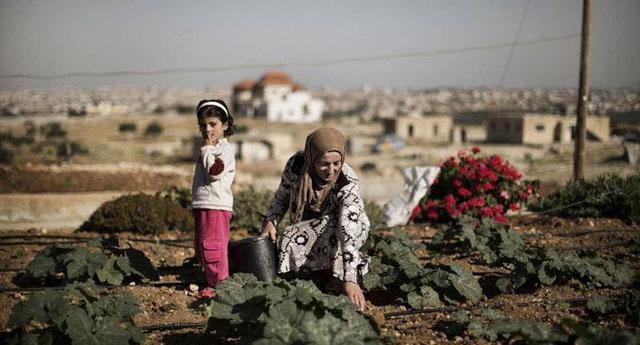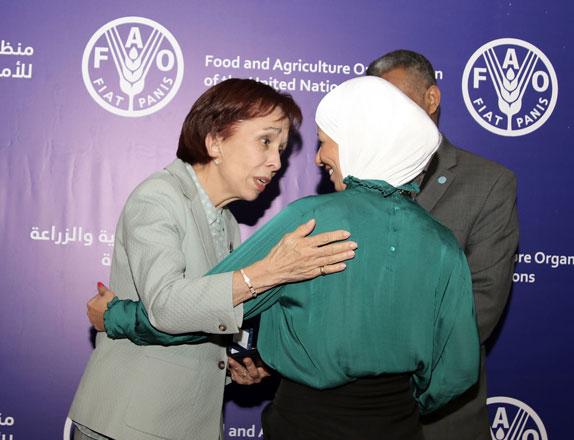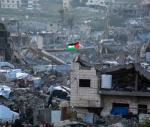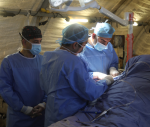You are here
Urban gardening project’s pilot phase in Mafraq, Irbid bears fruit
By Khetam Malkawi - Sep 11,2016 - Last updated at Sep 11,2016

Participants in a project implemented by the UN Food and Agriculture Organisation in northern Jordan use a ‘soilless mechanism’ to grow plants for food production recently (Photo courtesy of FAO)
AMMAN — Although it was implemented on a limited scale, a project by the UN Food and Agriculture Organisation (FAO) in Jordan has proven that “urban gardening” can be a partial solution to food insecurity in the country, according to the agency.
Titled “Enhance Food Security and Nutrition for the Most Vulnerable Jordanians and Syrian Refugee Households through Improved Access to Safe and Nutritional Food”, the six-month project concluded earlier this year and was implemented in the northern governorates of Mafraq and Irbid.
“Instead of buying the vegetables I need for cooking, I managed to produce them in my backyard,” said Umm Fadi, one of the beneficiaries of the project.
The Mafraq resident said that after taking part in the FAO training and with close follow-up by experts, she has been able to plant what she needs.
“It is a great feeling to cut costs by planting what you need at home. I planted lettuce, onion, spinach, cauliflower and other vegetables needed at any household,” the 60-year-old told The Jordan Times, adding that she also allowed a neighbour to use the space around her house to plant what she needs.
“Instead of paying JD1 for one kilogramme of certain types of vegetables, I save the money now to spend it on other needs.”
FAO Representative to Jordan Nasredin Hag Elamin said that based on the results of the first phase, the project will be scaled up and will this time benefit female-headed households.
In an interview with The Jordan Times, he explained that the project will also target families that do not have land to cultivate to train them on how to plant and produce fruit and vegetables even without having land.
The first phase of the project included 500 household beneficiaries in Irbid and Mafraq, two of the most affected governorates in the Kingdom due to the Syrian refugee crisis, according to Maha Qashou, who served as FAO lead officer for the project when it was implemented.
Families are trained on how to cultivate without having lands, using a “soilless mechanism” to achieve food security.
Although the project’s main target was to realise food security to some extent in the targeted areas, it also aimed at achieving social cohesion between Jordanians and Syrians, according to Qashou.
She explained that the project that was implemented in partnership with the Agency for Technical Cooperation and Development, provided training to individuals through community based organisations (CBOs).
In addition, the needed equipment was distributed to beneficiaries to use them in the implementation phase without incurring any cost.
Soilless units were distributed to families to use them at home, whether on the house roof or on balconies and to CBOs that have gardens which some beneficiaries can use.
Beneficiaries were also trained on irrigation methods and pest management, added Qashou.
Farah Rshoud, the president of one of the CBOs that benefited from the project in Mafraq, 80km northeast of Amman, said this was the first project her organisation implements.
“It was difficult in the beginning and some of the women were reluctant to take part in it,” Rshoud told The Jordan Times. However, when they became more involved in the project and noticed its impact on their food security, things changed.
“Thus, we will be a partner in the second phase of the project,” she said, adding that several women have approached her organisation asking for training and to be included in the second stage.
Rshoud added that 50 individuals took part in the first phase through her organisation, called Nawafeth in Arabic (windows), and 20 will be part of the second phase, which will be implemented soon.
According to Hag Elamin, the project has benefited both individuals and communities.
In Jordan, he noted, realising food security is challenging as the Kingdom is suffering from extreme scarcity of water and land. So, “you cannot produce enough”.
The Kingdom, he noted, needs a long-term perspective to deal with this challenge.
Jordan is located in the dry zone, and subject to recurrent draught, in addition to the impact of climate change. “Even the frost here has become more recurrent,” the UN official added.
As a result, he explained, Jordan is becoming increasingly dependent on imports, with almost 80 per cent of the country’s food needs and 90 per cent of cereals imported.
Other challenges, according to the FAO representative, are also emerging, such as the population growth due to the refugee crisis.
With the Syrian refugee influx to the Kingdom, water consumption has increased by 20 per cent and 40 per cent in the northern governorates alone.
In addition, this crisis has led to a hike in food prices.
“This is an emerging challenge but it is a long-term one,” Hag Elamin noted.
Another factor that affects food security in Jordan is food loss and waste which is estimated by one-third.
Meanwhile, although the Kingdom has achieved the Millennium Development Goal on reducing hunger in 2013, the impact of the Syrian crisis at the regional and national levels is endangering this achievement, according to Hag Elamin.
“A study by FAO will be conducted end of this year,” he said.
A FAO study conducted in 2014 in the northern governorates found that 15 per cent of households do not consume enough healthy and necessary food.
According to the 2015 Global Food Security Index, Jordan ranked 55th among 109 world countries in terms of food security. Regionally it ranked 8th among 12 countries covered by the index.
According to FAO, the Near East and North Africa region faces unprecedented challenges to food security and nutrition, especially in the countries that are now under conflict. At a meeting of experts that took place in Amman last year, figures released showed that the number of food insecure people in the region reached 33 million in 2014, more than double the figure in 2012.
“The old challenge stemming from the scarcity of water and the growing demand for food is becoming each year more stringent, with the increasing population and the changes in climate,” said Abdessalam Ould Ahmed, FAO assistant director general and regional representative.
The region, he noted, is already using more than 80 per cent of the freshwater available for agriculture, and imports more than 50 per cent of its calorie consumption.
There are limited possibilities to allocate more water for agricultural production, Ould Ahmed added.
According to the UN official, the most pressing challenge to food security and nutrition in the region today comes from “conflicts and protracted crises and their devastating consequences”.
Related Articles
Although Jordan achieved the Millennium Development Goal on reducing hunger in 2013, the impact of the Syrian crisis at regional and national levels is endangering this achievement, UN officials said.
Jordan and the Food and Agriculture Organisation (FAO) will implement three projects to improve food security and nutrition in regions affected by the Syrian crisis.
AMMAN — Jordan on Thursday joined the international community in marking World Food Day, which is celebrated annually in honour of the UN Fo

















